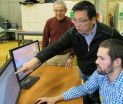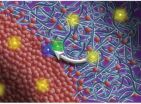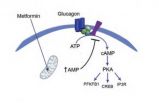(Press-News.org) EUGENE, Ore. -- (Jan. 7, 2013) -- The ability to focus and switch tasks readily amid distractions was compromised for up to two months following brain concussions suffered by high school athletes, according to a study at the University of Oregon.
Research team members, in an interview, said the discovery suggests that some athletes may need longer recovery periods than current practices dictate to lower the risk of subsequent concussions. Conventional wisdom, said lead author David Howell, a graduate student in the UO Department of Human Physiology, has typical recovery at seven to 10 days.
"The differences we detected may be a matter of milliseconds between a concussed person and a control subject, but as far as brain time goes that difference for a linebacker returning to competition too soon could mean the difference between another injury or successfully preparing to safely tackle an oncoming running back," Howell said.
The findings are based on cognitive exercises used five times over the two months with a pair of sensitive computer-based measuring tools -- the attentional network test and the task-switching test. The study focused on the effects of concussions to the frontal region of the brain, which is responsible for working, or short-term, memory and executive function, said Li-Shan Chou, professor of human physiology and director of the UO Motion Analysis Laboratory.
The study was published online ahead of print by Medicine & Science in Sports & Exercise, the official journal of the American College of Sports Medicine.
"If a person goes back to the playing field without a full recovery, that person is put into great danger of being re-injured," Chou said. "In any given season, if you suffer a concussion, the chances of your suffering a second one is three to six times higher and suffering a third is eight times higher. There are accumulations in this kind of injury. It doesn't go away easily."
A big unknown, the researchers said, is just how serious such injuries are for adolescents, whose brains are still developing. It could be the brain can recover more easily, or such injuries could continue to produce deficits that last a lifetime. "We just don't know," Chou said, adding that most previous studies have involved college-aged athletes and older adults.
Each year, there are 300,000 to 500,000 mild traumatic brain injury incidents, or concussions, with 100,000 tied to football, Chou said. He also cited a 2011 report from the Centers for Disease Control and Prevention that called such injuries a silent epidemic, with sports-related concussions in youths rising by 60 percent in the last decade. Another source of concussions, he added, is improvised explosive devices used in warfare.
Through an arrangement with Eugene-area schools, 20 high school athletes who had suffered a concussion -- primarily football players but also others from soccer, volleyball and wrestling -- were assessed within 72 hours of injury and then again one week, two weeks, a month and two months later. Each of the subjects, whose diagnosis was made by a certified athletic trainer and/or physician, was matched with a healthy control subject of the same sex, body size, age and sport.
"After two months following the concussions, these individuals were still significantly impaired in their executive function, compared to age-matched, activity-matched and gender-matched control populations," said co-author Louis Osternig, professor emeritus of human physiology and a fellow of the American College of Sports Medicine.
Osternig, also a certified athletic trainer, noted that self-reports by the subjects about how they were feeling sometimes were at odds with test results, which continued to show subtle deficits in cognitive functioning. The researchers also noted anecdotal reports from concussed athletes and their parents of declines in academic performance during the two-month period.
Additional data linking the deficits found in cognitive testing to the subjects' gait -- their task-shifting abilities while walking -- currently are being analyzed in the ongoing project, which is funded by the Department of Defense Telemedicine & Advanced Technology Research Center (W81XWH-11-1-0717), National Athletic Trainers Association, Veterans Administration and a translational research award from a joint UO-PeaceHealth Oregon Region collaboration program.
"By using tools from cognitive psychology, neuroscience and human physiology, this interdisciplinary team of scientists is improving our understanding of how brain trauma affects reaction time, and they are helping to create better outcomes for athletes, soldiers and others who are affected by concussions," said Kimberly Andrews Espy, vice president for research and innovation and dean of the graduate school. "UO researchers are working to improve the health and well-being of people in our local communities and throughout the world."
"The brain is the controller of our body movement," Chou said. "If you have a brain injury, are there any differences that we can pick up in the way a subject moves the body? In this lab, we are using motion analysis as a way to detect any deficiencies or abnormalities of body movement."
Chou said that his lab's goal, for now, is to disseminate the findings to the public and to talk to parents, athletic trainers and, perhaps, coaches directly to say: "These are the facts. We may not be able to draw any line on what clinically should or shouldn't be done. However, these are our observations based on our scientific testing."
INFORMATION:
Additional co-authors on the study were Ulrich Mayr, a UO psychology professor, and Paul van Donkelaar, a former UO human physiology professor now at the University of British Columbia. Both are experts on the testing methodologies.
About the University of Oregon
The University of Oregon is among the 108 institutions chosen from 4,633 U.S. universities for top-tier designation of "Very High Research Activity" in the 2010 Carnegie Classification of Institutions of Higher Education. The UO also is one of two Pacific Northwest members of the Association of American Universities.
Sources:
Li-Shan Chou
professor of human physiology
541-346-3391
chou@uoregon.edu
David Howell
graduate student
human physiology
541-346-1033
dhowell@uoregon.edu
Louis Osternig
541-346-3384
louiso@uoregon.edu
Links:
Chou faculty page: http://physiology.uoregon.edu/people/chou
Motion Analysis Laboratory: http://biomechanics.uoregon.edu/MAL/index.html
Osternig faculty page: http://physiology.uoregon.edu/people/osternig
Department of Human Physiology: http://physiology.uoregon.edu/
About the 2011 CDC report: http://www.cdc.gov/media/releases/2011/p1006_TBI_Youth.html
AUDIO (Similar summaries):
From David Howell: bit.ly/Vj5ySh
From Li-Shan Chou: bit.ly/VuyMxf
From Louis Osternig: bit.ly/S5clT2
Follow UO Science on Facebook:
http://www.facebook.com/UniversityOfOregonScience
Note: The University of Oregon is equipped with an on-campus television studio with satellite uplink capacity, and a radio studio with an ISDN phone line for broadcast-quality radio interviews. Call the Media Contact above to begin the process.
Cognitive deficits from concussions still present after 2 months
University of Oregon researchers deploy sensitive brain-testing methods on injured high school athletes
2013-01-07
ELSE PRESS RELEASES FROM THIS DATE:
Detrimental effect of obesity on lesions associated with Alzheimer's disease
2013-01-07
In France, more than 860,000 people suffer from Alzheimer's disease and related disorders, making them the largest cause of age-related loss of intellectual function. Cognitive impairments observed in Alzheimer's disease result from the accumulation of abnormal tau proteins in nerve cells undergoing degeneration . We know that obesity, a major risk factor in the development of insulin resistance and type 2 diabetes, increases the risk of dementia during the aging process. However, the effects of obesity on 'Taupathies' (i.e. tau protein-related disorders), including Alzheimer's ...
Penn study shows mountains are only minor contributors to erosion and climate regulation
2013-01-07
PHILADELPHIA — Though churning smokestacks, cud-chewing cows and gasoline-burning vehicles are contributing constantly to greenhouse gas emissions, there are also many processes that do the reverse, pulling molecules like carbon dioxide out of the atmosphere. One of these is chemical weathering, which occurs when rock turns into soil. Carbon dioxide molecules and rain combine to dissolve rock, and the weathering products, including sediment, eventually make their way through waterways to the ocean where some become trapped on the ocean bottom and in coral reefs and seashells.
For ...
A French nuclear exit?
2013-01-07
Los Angeles, CA (January 07, 2013). France has been held up, worldwide, as the forerunner in using nuclear fission to produce electricity. However, a third of the nation's nuclear reactors will need replacing in the next decade, and public opinion has shifted toward reducing reliance on nuclear power. In a special issue of the Bulletin of the Atomic Scientists, published by SAGE four articles explore whether France has the means or desire to unplug from nuclear power.
Nuclear arms experts Patrice Bouveret, Bruno Barrillot, and Dominique Lalanne argue that phasing out ...
Timely reminders boost childhood immunizations rates
2013-01-07
AURORA, Colo. (Jan. 7, 2013) – New research from the Children's Outcomes Research Program at Children's Hospital Colorado shows that timely reminders by state or local health departments are more effective at increasing immunization rates among preschool children than those from primary care practices.
The study, published December 13 in the American Journal of Public Health, underscores the importance of partnerships between state and county health departments and primary care practices to keep children up-to-date on recommended vaccines.
"Immunizations provide ...
Racial essentialism reduces creative thinking, makes people more closed-minded
2013-01-07
New research suggests that racial stereotypes and creativity have more in common than we might think.
In an article published in Psychological Science, a journal of the Association for Psychological Science, researcher Carmit Tadmor of Tel Aviv University and colleagues find that racial stereotyping and creative stagnation share a common mechanism: categorical thinking.
"Although these two concepts concern very different outcomes, they both occur when people fixate on existing category information and conventional mindsets," Tadmor and her colleagues write.
The researchers ...
New path to more efficient organic solar cells uncovered at Berkeley Lab's advanced light source
2013-01-07
Why are efficient and affordable solar cells so highly coveted? Volume. The amount of solar energy lighting up Earth's land mass every year is nearly 3,000 times the total amount of annual human energy use. But to compete with energy from fossil fuels, photovoltaic devices must convert sunlight to electricity with a certain measure of efficiency. For polymer-based organic photovoltaic cells, which are far less expensive to manufacture than silicon-based solar cells, scientists have long believed that the key to high efficiencies rests in the purity of the polymer/organic ...
How the kilogram has put on weight
2013-01-07
Post-Christmas and most of us are feeling the over-indulgence. But take heart - experts at Newcastle University, UK, have shown even the kilogram itself has put on weight. Using a state-of-the-art Theta-probe XPS machine – the only one of its kind in the world – the team have shown the original kilogram is likely to be tens of micrograms heavier than it was when the first standard was set in 1875.
And they say a suntan could be the key to helping it lose weight.
The original kilogram – known as the International Prototype Kilogram or the IPK – is the standard against ...
New antimatter method to provide 'a major experimental advantage'
2013-01-07
Researchers have proposed a method for cooling trapped antihydrogen which they believe could provide 'a major experimental advantage' and help to map the mysterious properties of antimatter that have to date remained elusive.
The new method, developed by a group of researchers from the USA and Canada, could potentially cool trapped antihydrogen atoms to temperatures 25 times colder than already achieved, making them much more stable and a lot easier to experiment on.
The suggested method, which has been published today, 7 January 2013, in IOP Publishing's Journal of ...
Most-used diabetes drug works in different way than previously thought
2013-01-07
PHILADELPHIA - A team, led by senior author Morris J. Birnbaum, MD, PhD, the Willard and Rhoda Ware Professor of Medicine, with the Institute for Diabetes, Obesity, and Metabolism, Perelman School of Medicine, University of Pennsylvania, found that the diabetes drug metformin works in a different way than previously understood. Their research in mice found that metformin suppresses the liver hormone glucagon's ability to generate an important signaling molecule, pointing to new drug targets. The findings were published online this week in Nature.
For fifty years, one ...
Genetic mystery of Behcet's disease unfolds along the ancient Silk Road
2013-01-07
Researchers have identified four new regions on the human genome associated with Behcet's disease, a painful and potentially dangerous condition found predominantly in people with ancestors along the Silk Road. For nearly 2,000 years, traders used this 4,000-mile network linking the Far East with Europe to exchange goods, culture and, in the case of the Silk Road disease, genes. National Institutes of Health researchers and their Turkish and Japanese collaborators published their findings in the Jan. 6, 2013, advance online issue of Nature Genetics.
Named for the Turkish ...
LAST 30 PRESS RELEASES:
Making lighter work of calculating fluid and heat flow
Normalizing blood sugar can halve heart attack risk
Lowering blood sugar cuts heart attack risk in people with prediabetes
Study links genetic variants to risk of blinding eye disease in premature infants
Non-opioid ‘pain sponge’ therapy halts cartilage degeneration and relieves chronic pain
AI can pick up cultural values by mimicking how kids learn
China’s ecological redlines offer fast track to 30 x 30 global conservation goal
Invisible indoor threats: emerging household contaminants and their growing risks to human health
Adding antibody treatment to chemo boosts outcomes for children with rare cancer
Germline pathogenic variants among women without a history of breast cancer
Tanning beds triple melanoma risk, potentially causing broad DNA damage
Unique bond identified as key to viral infection speed
Indoor tanning makes youthful skin much older on a genetic level
Mouse model sheds new light on the causes and potential solutions to human GI problems linked to muscular dystrophy
The Journal of Nuclear Medicine ahead-of-print tip sheet: December 12, 2025
Smarter tools for peering into the microscopic world
Applications open for funding to conduct research in the Kinsey Institute archives
Global measure underestimates the severity of food insecurity
Child survivors of critical illness are missing out on timely follow up care
Risk-based vs annual breast cancer screening / the WISDOM randomized clinical trial
University of Toronto launches Electric Vehicle Innovation Ontario to accelerate advanced EV technologies and build Canada’s innovation advantage
Early relapse predicts poor outcomes in aggressive blood cancer
American College of Lifestyle Medicine applauds two CMS models aligned with lifestyle medicine practice and reimbursement
Clinical trial finds cannabis use not a barrier to quitting nicotine vaping
Supplemental nutrition assistance program policies and food insecurity
Switching immune cells to “night mode” could limit damage after a heart attack, study suggests
URI-based Global RIghts Project report spotlights continued troubling trends in worldwide inhumane treatment
Neutrophils are less aggressive at night, explaining why nighttime heart attacks cause less damage than daytime events
Menopausal hormone therapy may not pose breast cancer risk for women with BRCA mutations
Mobile health tool may improve quality of life for adolescent and young adult breast cancer survivors
[Press-News.org] Cognitive deficits from concussions still present after 2 monthsUniversity of Oregon researchers deploy sensitive brain-testing methods on injured high school athletes


